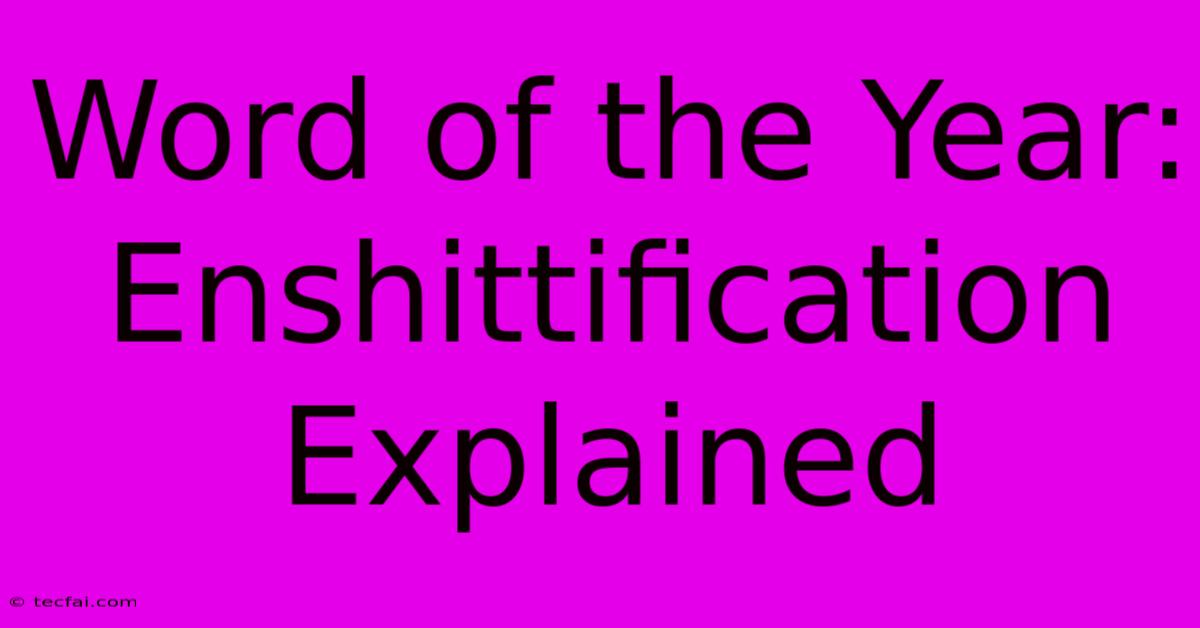Word Of The Year: Enshittification Explained

Discover more detailed and exciting information on our website. Click the link below to start your adventure: Visit Best Website tecfai.com. Don't miss out!
Table of Contents
Word of the Year: Enshittification Explained
The internet, that boundless digital frontier, is a landscape constantly evolving. Each year brings new trends, new technologies, and new words to capture the zeitgeist. While some years might see a gentle, almost predictable word rise to the top, others—like 2023—throw us a curveball in the form of a word that perfectly encapsulates the anxieties and frustrations of the modern digital age: enshittification. But what does this rather pungent term actually mean? Let's delve in.
Understanding the Nuances of "Enshittification"
Coined by internet writer, Cory Doctorow, "enshittification" describes a specific process: the gradual degradation of a service, product, or platform through a series of seemingly small, incremental changes. These changes, often driven by profit maximization, erode the user experience and ultimately diminish the value offered. It's not about a sudden, catastrophic failure; it's a slow, insidious poisoning of what was once good.
Think about it: your favorite free online service, once a haven of clean design and intuitive functionality, slowly becomes cluttered with intrusive ads, unnecessary features, and complicated user interfaces. This is enshittification in action. The core value proposition—the reason you originally loved the service—is gradually eroded, replaced by a frustrating and often exploitative experience.
Key Characteristics of Enshittification:
- Profit-Driven Degradation: The driving force behind enshittification is almost always financial. Companies prioritize maximizing profits, even if it means sacrificing user experience.
- Incremental Changes: The process is rarely sudden. Changes are rolled out gradually, making it difficult for users to pinpoint the exact moment the service started to decline.
- Erosion of User Experience: The ultimate outcome is a diminished user experience, characterized by frustration, inconvenience, and a general sense of dissatisfaction.
- Focus on Monetization: The focus shifts from providing a valuable service to extracting as much revenue as possible from users, often through aggressive advertising or subscription models.
Examples of Enshittification in the Real World
Many online services have fallen prey to enshittification. Consider:
- Social Media Platforms: The rampant spread of misinformation, toxic comments, and intrusive advertising on many social media sites are prime examples. The core value of connection is increasingly overshadowed by a chaotic and often unpleasant user experience.
- Streaming Services: The rise of increasingly expensive subscription packages, coupled with the introduction of ads on previously ad-free tiers, demonstrates how even successful services can succumb to enshittification.
- Free Online Tools: Many once-useful free online tools have become cluttered with ads, confusing interfaces, and limited functionality, making them far less useful than they once were.
Fighting Back Against Enshittification
While the process of enshittification can feel inevitable, there are things users can do:
- Vote with your wallet (or your time): Support services that prioritize user experience over profit maximization. Avoid using platforms that demonstrate clear signs of enshittification.
- Spread awareness: Talk to others about the dangers of enshittification. Help others understand this process so they can make informed choices about the services they use.
- Support open-source alternatives: Consider using open-source software and services. These are often less susceptible to enshittification due to community oversight and transparency.
Conclusion: More Than Just a Buzzword
"Enshittification" isn't just a trendy internet buzzword; it's a powerful term that describes a real and concerning phenomenon. Understanding this process is crucial for navigating the ever-changing landscape of online services and making informed choices about the platforms we use. By recognizing the signs and actively resisting enshittification, we can help preserve the quality of the online experiences we value. The fight for a better internet is a continuous one, and understanding the enemy is the first step to victory.

Thank you for visiting our website wich cover about Word Of The Year: Enshittification Explained. We hope the information provided has been useful to you. Feel free to contact us if you have any questions or need further assistance. See you next time and dont miss to bookmark.
Featured Posts
-
Lana Del Rey Uk Stadium Tour 2025
Nov 26, 2024
-
La Chargers Flag Football Photos
Nov 26, 2024
-
Menendez Brothers Freedom Bid Resentencing
Nov 26, 2024
-
Clippers Vs Celtics A Season Preview
Nov 26, 2024
-
Lowcountry Doctors Report Walking Pneumonia Rise
Nov 26, 2024
